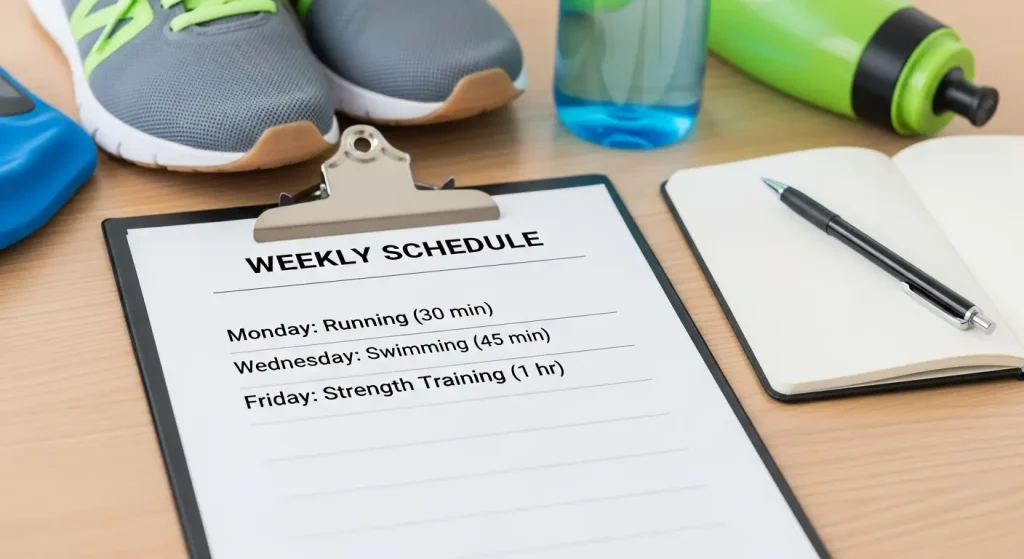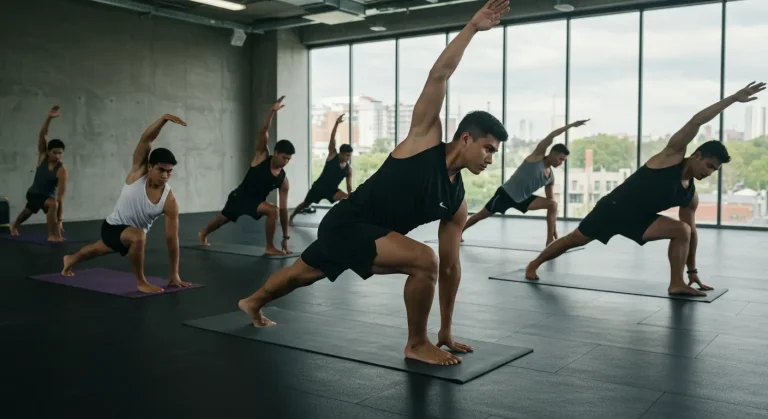When it comes to fitness, many of us often find ourselves juggling between busy schedules and the desire to stay in shape. “How can I stay active while keeping my life balanced?” or “How do I start a fitness routine that I can stick with?” are common concerns. These are not just common questions but obstacles we all face at some point. That’s why having a simple weekly sports schedule can be the perfect solution for better fitness results.

In this article, I’ll walk you through the steps of building a simple yet effective weekly sports schedule that will fit your life. Whether you’re just starting out or you’re looking to enhance your current routine, this schedule can serve as a reliable guide to help you achieve consistent results.
Why Should You Have a Weekly Sports Schedule?
You might be wondering: “What’s the point of having a structured sports schedule?” The reality is, a schedule can do wonders for your fitness goals. Without a set plan, it’s easy to get distracted, make excuses, or lose motivation. A solid plan ensures that your time is utilized efficiently and that you’re hitting all the important areas of fitness. It provides structure to your week and helps you stay focused on your goals.
By structuring your week with dedicated days for different activities, you not only improve your physical health but also boost your mental clarity and emotional well-being. A structured routine creates consistency, and consistency leads to results. So, let’s get started on making your personalized sports schedule.
How to Build Your Weekly Sports Schedule
Creating a weekly sports schedule is simpler than it sounds. You don’t need to be an expert to design a plan that works. Here’s how to break it down step by step:
Step 1: Set Clear Fitness Goals
Before you dive into scheduling, it’s important to know what you’re aiming for. Ask yourself these questions:
- Are you looking to lose weight, build muscle, or just stay active?
- Do you have a specific sports activity or workout you enjoy, like running, cycling, or weightlifting?
- How much time can you commit to each week?
Your answers will guide the structure of your weekly schedule. If you’re aiming for weight loss, for instance, your plan might include a mix of cardio and strength training. On the other hand, if you want to build muscle, you might focus more on strength workouts and rest days for muscle recovery.
Step 2: Plan for Rest Days
Rest is just as important as active days. Overtraining can lead to injuries and setbacks, so make sure your schedule includes adequate rest. A simple rule of thumb is to take at least one or two full rest days each week. Rest days allow your muscles to recover and your body to rebuild stronger.
Rest doesn’t necessarily mean doing nothing. Active rest, such as light stretching or yoga, can still keep your body moving without the intensity of a full workout.
Step 3: Mix Different Types of Workouts
A balanced sports schedule includes a variety of workouts to target different fitness components, such as strength, endurance, flexibility, and mobility. Here’s how you can break it down:
1. Cardio Training:
- Frequency: 2-3 days a week.
- Duration: 30-45 minutes per session.
- Example: Running, cycling, swimming, or HIIT (High-Intensity Interval Training).
2. Strength Training:
- Frequency: 2-3 days a week.
- Duration: 45-60 minutes per session.
- Example: Weight lifting, resistance band exercises, bodyweight exercises.
3. Flexibility & Mobility:
- Frequency: 2-3 days a week.
- Duration: 15-30 minutes per session.
- Example: Yoga, dynamic stretches, foam rolling.
4. Sport-Specific Training:
- Frequency: 1-2 days a week (if you play a sport).
- Duration: 45-60 minutes per session.
- Example: Basketball, soccer, tennis, or swimming.
Step 4: Incorporate Time for Recovery and Warm-Up
A warm-up before every workout and recovery afterward are crucial to injury prevention. Warm-ups prepare your body for the intensity of exercise and gradually raise your heart rate. Similarly, cooldowns help relax your muscles after a workout and prevent stiffness. Include 5-10 minutes for each before and after every workout.
Step 5: Stay Consistent and Adaptable
Having a consistent weekly routine is key, but life happens. There may be weeks when you can’t stick to the plan exactly as written. That’s okay! The important thing is to keep moving forward. Adapt your schedule if needed but stay committed to making fitness a priority.
Discover details about Sophie Rain.
Sample Weekly Sports Schedule
Here’s an example of what a simple weekly schedule could look like, based on the guidelines above:
| Day | Activity | Time | Notes |
| Monday | Cardio (Jogging or Cycling) | 30-45 mins | Focus on moderate intensity |
| Tuesday | Strength Training (Upper Body) | 45-60 mins | Target chest, back, shoulders |
| Wednesday | Yoga / Flexibility | 30 mins | Improve flexibility & recovery |
| Thursday | Cardio (HIIT or Running) | 30-45 mins | High intensity interval training |
| Friday | Strength Training (Lower Body) | 45-60 mins | Target legs and core |
| Saturday | Active Rest (Light walk or stretch) | 20-30 mins | Active recovery day |
| Sunday | Sport-Specific Training or Rest | 45 mins to 1 hr | Play your favorite sport or rest |
How to Track Your Progress
Tracking your progress is essential for staying motivated and assessing whether your routine is working. Keep a fitness journal or use fitness apps to log your workouts, set goals, and monitor improvements over time. Whether it’s lifting heavier weights, running faster, or holding a yoga pose longer, seeing your progress is a powerful motivator.
Real-Life Example:
I had a friend who struggled with staying motivated in their fitness journey. After creating a simple weekly sports schedule, they started tracking their results. They saw significant improvements in endurance and strength within just a few weeks. That progress kept them engaged, and they found themselves sticking to their routine.
Explore Why Yoga Should Be Part of Every Athlete’s Training Plan
Conclusion
Building a simple weekly sports schedule doesn’t have to be complicated. With clear goals, rest days, and a balanced mix of workouts, you can achieve consistent fitness results without feeling overwhelmed. The key is to stay flexible, be consistent, and adapt the schedule as your body gets stronger. Most importantly, make sure you’re enjoying the process—because when fitness feels enjoyable, it becomes a lifestyle.
Your fitness journey is unique, so feel free to adjust your schedule to suit your personal preferences and goals. As long as you stay committed and track your progress, you’ll be on your way to seeing the results you’ve been working for.






